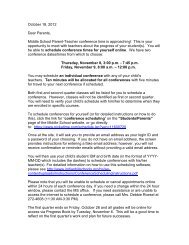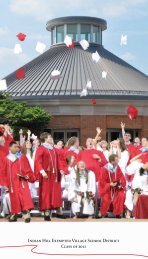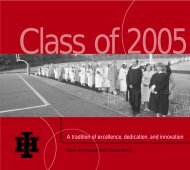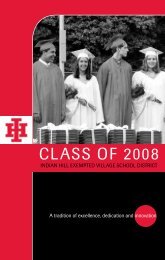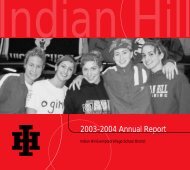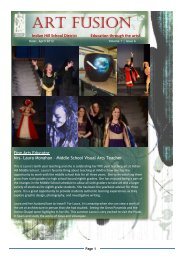Writing, Language, Speaking & Listening Core Curriculum for K-5
Writing, Language, Speaking & Listening Core Curriculum for K-5
Writing, Language, Speaking & Listening Core Curriculum for K-5
- No tags were found...
Create successful ePaper yourself
Turn your PDF publications into a flip-book with our unique Google optimized e-Paper software.
SCHOOL PERFORMANCE IN STATEWIDE TESTS AND EXAMINATIONSWaverley College Students took part in the following Statewide Assessments, Tests and Examinations during2005:• Basic Skills Test - Year 5• English <strong>Language</strong> & Literacy Assessment – Years 7 & 8• Secondary Numeracy Assessment Program – Years 7 & 8• School Certificate Examinations <strong>for</strong> Year 10 in:o English Literacyo Mathematicso Scienceo Australian History, Geography, Civics & Citizenship• Higher School Certificate <strong>for</strong> Year 12 in 36 Courses.The following graphs provide in<strong>for</strong>mation on the per<strong>for</strong>mance of Waverley College students in these publicassessments, tests and examinations in comparison to the cohort across the State of NSW.2
Grade 1: <strong>Language</strong> StandardsStudents will…….Conventions of Standard English1. Demonstrate command of the conventions of standard English grammar and usage when writing orspeaking.a. Print all upper and lowercase letters.b. Use common, proper, and possessive nouns.c. Use singular and plural nouns with matching verbs in basic sentences (e.g., He hops; We hop).d. Use personal, possessive, & indefinite pronouns (e.g., I, me, my; they, them, their; anyone, everything).e. Use verbs to convey a sense of past, present, and future (e.g., Yesterday I walked home; Today Iwalk home; Tomorrow I will walk home).f. Use frequently occurring adjectives.g. Use frequently occurring conjunctions (e.g., and, but, or, so, because).h. Use determiners (e.g., articles, demonstratives).i. Use frequently occurring prepositions (e.g., during, beyond, toward).j. Produce and expand complete simple and compound declarative, interrogative, imperative, andexclamatory sentences in response to prompts.2. Demonstrate command of the conventions of standard English capitalization, punctuation, and spelling whenwriting.a. Capitalize dates and names of people.b. Use end punctuation <strong>for</strong> sentences.c. Use commas in dates and to separate single words in a series.d. Use conventional spelling <strong>for</strong> words with common spelling patterns and <strong>for</strong> frequently occurringirregular words.e. Spell untaught words phonetically, drawing on phonemic awareness and spelling conventions.Knowledge of <strong>Language</strong>3. (This anchor standard begins in grade 2).Vocabulary Acquisition and Use4. Determine or clarify the meaning of unknown and multiple-meaning words and phrases based on grade 1reading and content, choosing flexibly from an array of strategies.a. Use sentence-level context as a clue to the meaning of a word or phrase.b. Use frequently occurring affixes as a clue to the meaning of a word.c. Identify frequently occurring root words (e.g., look) & their inflectional <strong>for</strong>ms (e.g., looks, looked, looking).5. With guidance and support from adults, demonstrate understanding of word relationships and nuances inword meanings.a. Sort words into categories (e.g., colors, clothing) to gain a sense of the concepts the categoriesrepresent.b. Define words by category and by one or more key attributes (e.g., a duck is a bird that swims; a tigeris a large cat with stripes).c. Identify real-life connections between words and their use (e.g., note places at home that are cozy).d. Distinguish shades of meaning among verbs differing in manner (e.g., look, peek, glance, stare, glare,scowl) and adjectives differing in intensity (e.g., large, gigantic) by defining or choosing them or byacting out the meanings.6. Use words and phrases acquired through conversations, reading and being read to, and responding to texts,including using frequently occurring conjunctions to signal simple relationships (e.g., because).----------------------------------------------------------------------------------------------------------------
Grade 2: <strong>Language</strong> StandardsStudents will……Conventions of Standard English1. Demonstrate command of the conventions of standard English grammar & usage when writing or speaking.a. Use collective nouns (e.g., group).b. Form and use frequently occurring irregular plural nouns (e.g, feet, children, teeth, mice, fish).c. Use reflexive pronouns (e.g., myself, ourselves).d. Form and use the past tense of frequently occurring irregular verbs (e.g., sat, hid, told).e. Use adjectives and adverbs, and choose between them depending on what is to be modified.f. Produce, expand, and rearrange complete simple and compound sentences (e.g., The boy watchedthe movie; The little boy watched the movie; The action movie was watched by the little boy).2. Demonstrate command of the conventions of standard English capitalization, punctuation, and spelling whenwriting.a. Capitalize holidays, product names, and geographic names.b. Use commas in greetings and closings of letters.c. Use an apostrophe to <strong>for</strong>m contractions and frequently occurring possessives.d. Generalize learned spelling patterns when writing words (e.g., cage-badge; boy-boil).e. Consult reference materials, including beginning dictionaries, as needed to check and correctspellings.Knowledge of <strong>Language</strong>3. Use Knowledge of language and its conventions when writing, speaking, reading, or listening.a. Compare <strong>for</strong>mal and in<strong>for</strong>mal uses of English.Vocabulary Acquisition and Use4. Determine or clarify the meaning of unknown and multiple-meaning words and phrases based on grade 2reading and content, choosing flexibly from an array of strategies.a. Use sentence-level context as a clue to the meaning of a word or phrase.b. Determine the meaning of the new word <strong>for</strong>med when a known prefix is added to a known word (e.g.,happy/unhappy, tell/retell).c. Use a known root word as a clue to the meaning of an unknown word with the same root (e.g.,addition, additional).d. Use knowledge of the meaning of individual words to predict the meaning of compound words (e.g.,birdhouse, lighthouse, housefly; bookshelf, notebook, bookmark).e. Use glossaries and beginning dictionaries, both print and digital, to determine or clarify the meaningof words and phrases.5. Demonstrate understanding of word relationships and nuances in word meanings.a. Identify real-life connections between words and their use (e.g., describe foods that are spicy orjuicy).b. Distinguish shades of meaning among closely related verbs (e.g., toss, throw, hurl) and closelyrelated adjectives (e.g., thin, slender, skinny, scrawny).6. Use words and phrases acquired through conversations, reading & being read to, and responding to texts,including using adjectives and adverbs to describe (e.g., When other kids are happy that makes me happy).---------------------------------------------------------------------------------------------------------------------
Grade 3: <strong>Language</strong> StandardsStudents will…….Conventions of Standard English1. Demonstrate command of the conventions of standard English grammar & usage when writing or speaking.a. Explain the function of nouns, pronouns, verbs, adjectives, and adverbs in general and their functions inparticular sentences.b. Form and use regular and irregular plural nouns.c. Use abstract nouns (e.g., childhood).d. Form and use regular and irregular verbs.e. Form and use the simple (e.g., I walked; I walk; I will walk) verb tenses.f. Ensure subject-verb and pronoun-antecedent agreement.g. Form and use comparative and superlative adjectives and adverbs, and choose between them dependingon what is to be modified.h. Use coordinating and subordinating conjunctions.i. Produce simple, compound, and complex sentences.2. Demonstrate command of the conventions of standard English capitalization, punctuation, & spelling when writing.a. Capitalize appropriate words in titles.b. Use commas in addresses.c. Use commas and quotation marks in dialogue.d. Form and use possessives.e. Use conventional spelling <strong>for</strong> high-frequency and other studied words and <strong>for</strong> adding suffixes to basewords (e.g., sitting, smiled, cries, happiness).f. Use spelling patterns and generalizations (e.g., word families, position-based spellings, syllable patterns,ending rules, meaningful word parts) in writing words.g. Consult reference materials, including beginning dictionaries, as needed to check & correct spellings.Knowledge of <strong>Language</strong>3. Use knowledge of language and its conventions when writing, speaking, reading, or listening.a. Choose words and phrases <strong>for</strong> effect.b. Recognize & observe differences between the conventions of spoken and written standard English.Vocabulary Acquisition and Use4. Determine or clarify the meaning of unknown and multiple-meaning word and phrases based on grade 3 readingand content, choosing flexibly from a range of strategies.a. Use sentence-level context as a clue to the meaning of a word or phrase.b. Determine the meaning of the new word <strong>for</strong>med when a known affix is added to a known word (e.g.,agreeable/disagreeable, com<strong>for</strong>table/uncom<strong>for</strong>table, care/careless, heat/preheat).c. Use a known root word as a clue to the meaning of an unknown word with the same root (e.g., company,companion).d. Use glossaries or beginning dictionaries, both print and digital, to determine or clarify the precise meaningof key words and phrases.5. Demonstrate understanding of word relationships and nuances in word meanings.a. Distinguish the literal and on literal meanings of words and phrases in context (e.g., take steps).b. Identify real-life connections between words & their use (e.g. describe people who are friendly or helpful).c. Distinguish shades of meaning among related words that describe states of mind or degrees of certainty(e.g., knew, believed, suspected, heard, wondered).6. Acquire & use accurately grade-appropriate conversational, general academic, & domain-specific words andphrases, including those that signal spatial & temporal relationships (e.g., After dinner that night we went looking<strong>for</strong> them).---------------------------------------------------------------------------------------------------------------------
Grade 4: <strong>Language</strong> StandardsStudents will…….Conventions of Standard English1. Demonstrate command of the conventions of standard English grammar and usage when writing orspeaking.a. Use relative pronouns (who, whose, whom, which, that) and relative adverbs (where, when, why).b. Form and use the progressive (e.g., I was walking; I am walking; I will be walking) verb tenses.c. Use modal auxiliaries (e.g., can, may, must) to convey various conditions.d. Order adjectives within sentences according to conventional patterns (e.g., a small red bag ratherthan a red small bag).e. Form and use prepositional phrases.f. Produce complete sentences, recognizing and correcting inappropriate fragments and run-ons.g. Correctly use frequently confused words (e.g., to, too, two; there, their).2. Demonstrate command of the conventions of standard English capitalization, punctuation, and spellingwhen writing.a. Use correct capitalization.b. Use commas and quotation marks to mark direct speech and quotations from a text.c. Use a comma be<strong>for</strong>e a coordinating conjunction in a compound sentence.d. Spell grade-appropriate words correctly, consulting references as needed.Knowledge of <strong>Language</strong>3. Use knowledge of language and its conventions when writing, speaking, reading, or listening.a. Choose words and phrases to convey ideas precisely.b. Choose punctuation <strong>for</strong> effect.c. Differentiate between contexts that call <strong>for</strong> <strong>for</strong>mal English (e.g., presenting ideas) and situationswhere in<strong>for</strong>mal discourse is appropriate (e.g, small-group discussion).Vocabulary Acquisition and Use4. Determine or clarify the meaning of unknown and multiple-meaning words and phrases based on grade 4reading and content, choosing flexibly from a range of strategies.a. Use context (e.g., definitions, examples, or restatements in text) as a clue to the meaning of a word orphrase.b. Use common, grade-appropriate Greek and Latin affixes and roots as clues to the meaning of a word(e.g., telegraph, photograph, autograph).c. Consult references materials (e.g., dictionaries, glossaries, thesauruses), both print and digital, to findthe pronunciation and determine or clarify the precise meaning of key words and phrases.5. Demonstrate understanding of figurative language, word relationships, and nuances in word meanings.a. Explain the meaning of simple similes and metaphors (e.g., as pretty as a picture) in context.b. Recognize and explain the meaning of common idioms, adages, and proverbs.c. Demonstrate understanding of words by relating them to their opposites (antonyms) and to wordswith similar but not identical meanings (synonyms).6. Acquire and use accurately grade-appropriate general academic and domain-specific words andphrases, including those that signal precise actions, emotions, or states of being (e.g., quizzed, whined,stammered) and that are basic to a particular topic (e.g., wildlife, conservation, and endangered whendiscussing animal preservation).----------------------------------------------------------------------------------------------------------------
Grade 5: <strong>Language</strong> StandardsStudents will……Conventions of Standard English1. Demonstrate command of the conventions of standard English grammar and usage when writing orspeaking.a. Explain the function of conjunctions, prepositions, and interjections in general and their function inparticular sentences.b. Form and use the perfect (e.g., I had walked; I have walked; I will have walked) verb tenses.c. Use verb tense to convey various times, sequences, states, and conditions.d. Recognize and correct inappropriate shifts in verb tense.e. Use correlative conjunctions (e.g., either/or, neither/nor).2. Demonstrate command of the conventions of standard English capitalization, punctuation, and spellingwhen writing.a. Use punctuation to separate items in a series.b. Use a comma to separate an introductory element from the rest of the sentence.c. Use a comma to set off the words yes and no (e.g., Yes, thank you), to set off a tag question from therest of the sentence (e.g., It’s true, isn’t it?), and to indicate direct address (e.g., Is that you, Steve?).d. Use underlining, quotation marks, or italics to indicate titles of works.e. Spell grade-appropriate words correctly, consulting references as needed.Knowledge of <strong>Language</strong>3. Use knowledge of language and its conventions when writing, speaking, reading, or listening.a. Expand, combine, and reduce sentences <strong>for</strong> meaning, reader/listener interest, and style.b. Compare and contrast the varieties of English (e.g., dialects, registers) used in stories, dramas, orpoems.Vocabulary Acquisition and Use4. Determine or clarify the meaning of unknown and multiple – meaning words and phrases based on grade5 reading and content, choosing flexibly from a range of strategies.a. Use context (e.g., cause/effect relationships and comparisons in text) as a clue to the meaning of aword or phrase.b. Use common, grade-appropriate Greek and Latin affixes and roots as clues to the meaning of a word(e.g., photograph, photosynthesis).c. Consult reference materials (e.g., dictionaries, glossaries, thesauruses), both print and digital, to findthe pronunciation and determine or clarify the precise meaning of key words and phrases.5. Demonstrate understanding of figurative language, word relationships, and nuances in word meanings.a. Interpret figurative language, including similes and metaphors, in context.b. Recognize and explain the meaning of common idioms, adages, and proverbs.c. Use the relationship between particular words (e.g., synonyms, antonyms, homographs) to betterunderstand each of the words.6. Acquire and use accurately grade-appropriate general academic and domain-specific words andphrases, including those that signal contrast, addition, and other logical relationships (e.g., however,although, nevertheless, similarly, moreover, in addition).-------------------------------------------------------------------------------------------------------------------------------
Common <strong>Core</strong> <strong>Speaking</strong> & <strong>Listening</strong> Standards: Kindergarten - 5 th GradeCollege and Career Readiness <strong>for</strong> <strong>Speaking</strong> and <strong>Listening</strong>To build a foundation <strong>for</strong> college and career readiness, students must have ample opportunities to take part in avariety of rich, structured conversations-as part of a whole class, in small groups, and with a partner. Beingproductive members of these conversations requires that students contribute accurate, relevant in<strong>for</strong>mation;respond to and develop what others have said; make comparisons and contrasts; and analyze and synthesize amultitude of ideas in various domains.New technologies have broadened and expanded the role that speaking and listening play in acquiring and sharingknowledge and have tightened their link to other <strong>for</strong>ms of communication. Digital texts confront students with thepotential <strong>for</strong> continually updated content and dynamically changing combinations of words, graphics, images,hyperlinks, and embedded video and audio.Anchor Standards <strong>for</strong> <strong>Speaking</strong> and <strong>Listening</strong>The K-5 standards on the following pages define what students should understand and be able to do by the end ofeach grade. They correspond to the College and Career Readiness (CCR) anchor standards below by number. TheCCR and grade-specific standards are necessary complements-the <strong>for</strong>mer providing broad standards, the latterproviding additional specificity-that together define the skills and understandings that all students mustdemonstrate.Comprehension and Collaboration1. Prepare <strong>for</strong> and participate effectively in a range of conversations and collaborations with diverse partners,building on others’ ideas and expressing their own clearly and persuasively.2. Integrate & evaluate in<strong>for</strong>mation presented in diverse media & <strong>for</strong>mats, including visually, quantitatively, & orally.3. Evaluate a speaker’s point of view, reasoning, and use of evidence and rhetoric.Presentation of Knowledge and Ideas4. Present in<strong>for</strong>mation, findings, and supporting evidence such that listeners can follow the line of reasoningand the organization, development, and style are appropriate to task, purpose, and audience.5. Make strategic use of digital media and visual displays of data to express in<strong>for</strong>mation and enhanceunderstanding of presentations.6. Adapt speech to a variety of contexts and communicative tasks, demonstrating command of <strong>for</strong>mal Englishwhen indicated or appropriate.<strong>Speaking</strong> and <strong>Listening</strong> Standards K - 5The following standards <strong>for</strong> K -5 offer a focus <strong>for</strong> instruction each year to help ensure that students gain adequatemastery of a range of skills and applications. Students advancing through the grades are expected to meet eachyear’s grade-specific standards & retain or further develop skills and understandings mastered in preceding grades.Kindergarten: <strong>Speaking</strong> and <strong>Listening</strong> StandardsStudents will……Comprehension and Collaboration1. Participate in collaborative conversations with diverse partners about kindergarten topics and texts withpeers and adults in small and larger groups.a. Follow agreed-upon rules <strong>for</strong> discussions (e.g., listening to others and taking turns speaking aboutthe topics and texts under discussion).b. Continue a conversation through multiple exchanges.2. Confirm understanding of a text read aloud or in<strong>for</strong>mation presented orally or through other media by askingand answering questions about key details and requesting clarification if something is not understood.3. Ask and answer questions in order to seek help, get in<strong>for</strong>mation, or clarify something that is not understood.
Kindergarten: <strong>Speaking</strong> and <strong>Listening</strong> Standards - continuedPresentation of Knowledge and Ideas4. Describe familiar people, places, things, &d events &, with prompting and support, provide additional detail.5. Add drawings or other visual displays to descriptions as desired to provide additional detail.6. Speak audibly and express thoughts, feelings, and ideas clearly.--------------------------------------------------------------------------------------------------------------------------Grade 1: <strong>Speaking</strong> and <strong>Listening</strong> StandardsStudents will….Comprehension and Collaboration1. Participate in collaborative conversations with diverse partners about grade 1 topics and texts with peers andadults in small and larger groups.a. Follow agreed-upon rules <strong>for</strong> discussions (e.g., listening to others with care, speaking one at a time aboutthe topics and texts under discussion).b. Build on others’ talk in conversations by responding to the comments of others through multipleexchanges.c. Ask questions to clear up any confusion about the topics and texts under discussion.2. Ask and answer questions about key details in a text read aloud or in<strong>for</strong>mation presented orally or throughother media.3. Ask and answer questions about what a speaker says in order to gather additional in<strong>for</strong>mation or clarifysomething that is not understood.Presentation of Knowledge and Ideas4. Describe people, places, things, and events with relevant details, expressing ideas and feelings clearly.5. Add drawings or other visual displays to descriptions when appropriate to clarify ideas, thoughts, andfeelings.6. Produce complete sentences when appropriate to task & situation. (See grade 1 <strong>Language</strong> standards 1 and 3).-------------------------------------------------------------------------------------------------------------------Grade 2: <strong>Speaking</strong> and <strong>Listening</strong> StandardsStudents will….Comprehension and Collaboration1. Participate in collaborative conversations with divers partners about grade 2 topics and texts with peers andadults in small and larger groups.a. Follow agreed-upon rules <strong>for</strong> discussions (e.g., gaining the floor in respectful ways, listening to otherswith care, speaking one at a time about the topics and texts under discussion).b. Build on others’ talk in conversations by linking their comments to the remarks of others.c. Ask <strong>for</strong> clarification and further explanation as needed about the topics and texts under discussion.2. Recount or describe key ideas or details from a text read aloud or in<strong>for</strong>mation presented orally or throughother media.3. Ask and answer questions about what a speaker says in order to clarify comprehension, gather additionalin<strong>for</strong>mation, or deepen understanding of a topic or issue.Presentation of Knowledge and Ideas4. Tell a story or recount an experience with appropriate facts and relevant, descriptive details, speakingaudibly in coherent sentences.5. Create audio recordings of stories or poems; add drawings or other visual displays to stories or recounts ofexperiences when appropriate to clarify ideas, thoughts, and feelings.6. Produce complete sentences when appropriate to task and situation in order to provide requested detail orclarification. (See grade 2 language standards 1 and 3 <strong>for</strong> specific expectations).---------------------------------------------------------------------------------------------------------------------
Grade 3: <strong>Speaking</strong> and <strong>Listening</strong> StandardsStudents will….Comprehension and Collaboration1. Engage effectively in a range of collaborative discussions (one-on-one, in groups, and teacher-led) withdiverse partners on grade 3 topics and texts, building on others’ ideas and expressing their own clearly.a. Come to discussions prepared, having read or studied required material; explicitly draw on thatpreparation and other in<strong>for</strong>mation known about the topic to explore ideas under discussion.b. Follow agreed-upon rules <strong>for</strong> discussions (e.g., gaining the floor in respectful ways, listening to otherswith care, speaking one at a time about the topics and texts under discussion).c. Ask questions to check understanding of in<strong>for</strong>mation presented, stay on topic, and link their comments tothe remarks of others.d. Explain their own ideas and understanding in light of the discussion.2. Determine the main ideas and supporting details of a text read aloud or in<strong>for</strong>mation presented in diversemedia and <strong>for</strong>mats, including visually, quantitatively, and orally.3. Ask and answer questions about in<strong>for</strong>mation from a speaker, offering appropriate elaboration and detail.Presentation of Knowledge and ideas4. Report on a topic or text, tell a story, or recount an experience with appropriate facts and relevant,descriptive details, speaking clearly at an understandable pace.5. Create engaging audio recordings of stories or poems that demonstrate fluid reading at an understandablepace; add visual displays when appropriate to emphasize or enhance certain facts or details.6. Speak in complete sentences when appropriate to task and situation in order to provide requested detail orclarification. (See grade 3 <strong>Language</strong> standards 1 and 3 <strong>for</strong> specific expectations).---------------------------------------------------------------------------------------------------------------------Grade 4: <strong>Speaking</strong> and <strong>Listening</strong> StandardsStudents will….Comprehension and Collaboration1. Engage effectively in a range of collaborative discussions (one-on-one, in groups, and teacher-lead) withdiverse partners on grade 4 topics and texts, building on others’ ideas and expressing their own clearly.a. Come to discussions prepared, having read or studied required material; explicitly draw on thatpreparation and other in<strong>for</strong>mation known about the topic to explore ideas under discussion.b. Follow agreed-upon rules <strong>for</strong> discussions and carry out assigned roles.c. Pose and respond to specific questions to clarify or follow up on in<strong>for</strong>mation, and make comments thatcontribute to the discussion and link to the remarks of others.d. Review the key ideas expressed and explain their own ideas and understanding in light of the discussion.2. Paraphrase portions of a text read aloud or in<strong>for</strong>mation presented in divers media and <strong>for</strong>mat, includingvisually, quantitatively, and orally.3. Identify the reasons and evidence a speaker provides to support particular points.Presentation of Knowledge and Ideas4. Report on a topic or text, tell a story, or recount an experience in an organized manner, using appropriatefacts and relevant, descriptive details to support main ideas or themes; speak clearly at an understandablepace.5. Add audio recordings and visual displays to presentations when appropriate to enhance the development ofmain ideas or themes.6. Differentiate between contexts that call <strong>for</strong> <strong>for</strong>mal English (e.g., presenting ideas) and situations wherein<strong>for</strong>mal discourse is appropriate (e.g., small-group discussion); use <strong>for</strong>mal English when appropriate to taskand situation. (See grade 4 <strong>Language</strong> standard 1 <strong>for</strong> specific expectations.---------------------------------------------------------------------------------------------------------------------
Grade 5: <strong>Speaking</strong> and <strong>Listening</strong> StandardsStudents will….Comprehension and Collaboration1. Engage effectively in a range of collaborative discussions (one-on-one, in groups, and teacher-lead) withdiverse partners on grade 5 topics and texts, building on others’ ideas and expressing their own clearly.a. Come to discussions prepared, having read or studied required material; explicitly draw on thatpreparation and other in<strong>for</strong>mation known about the topic to explore ideas under discussion.b. Follow agreed-upon rules <strong>for</strong> discussions and carry out assigned roles.c. Pose and respond to specific questions by making comments that contribute to the discussion andelaborate on the remarks of others.d. Review the key ideas expressed and draw conclusion in light of in<strong>for</strong>mation and knowledge gainedfrom the discussion.2. Summarize a written text read aloud or in<strong>for</strong>mation presented in diverse media and <strong>for</strong>mat, includingvisually, quantitatively, and orally.3. Summarize the points a speaker makes and explain how each claim is supported by reasons andevidence.Presentation of Knowledge and Ideas4. Report on a topic or text or present an opinion, sequencing ideas logically and using appropriate factsand relevant, descriptive details to support main ideas or themes; speak clearly at an understandablepace.5. Include multimedia components (e.g., graphics, sound) and visual displays in presentations whenappropriate to enhance the development of main ideas or themes.6. Adapt speech to a variety of contexts and tasks, using <strong>for</strong>mal English when appropriate to task andsituation. (See grade 5 <strong>Language</strong> standard 3 <strong>for</strong> specific expectations.---------------------------------------------------------------------------------------------------------------------



